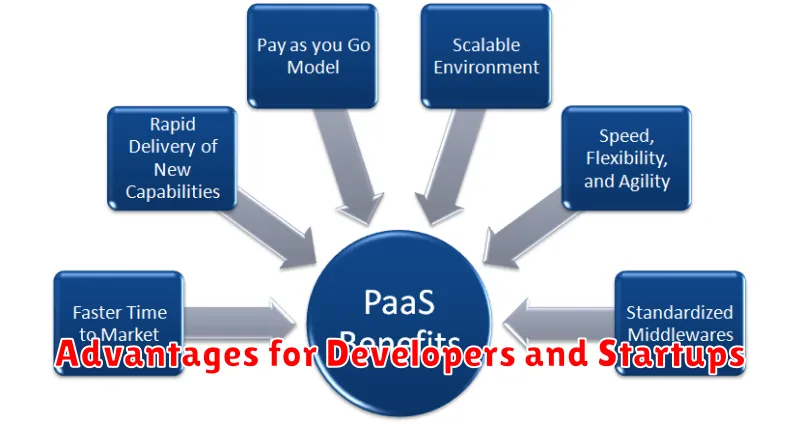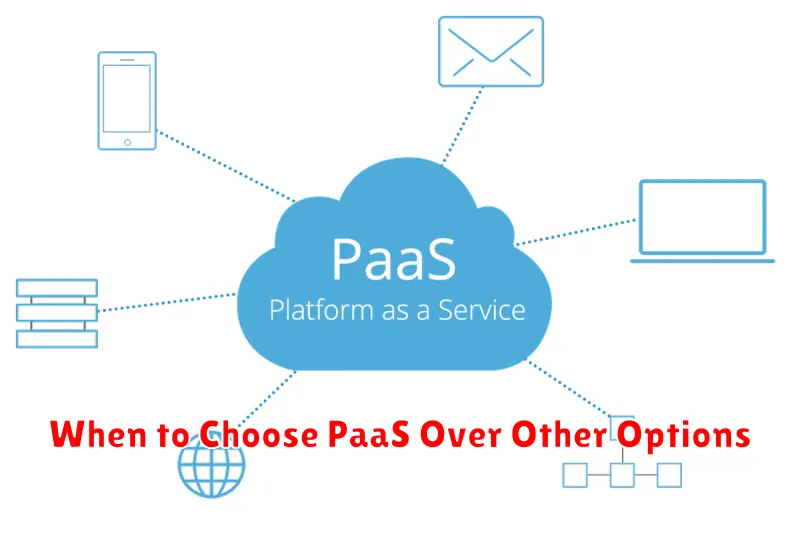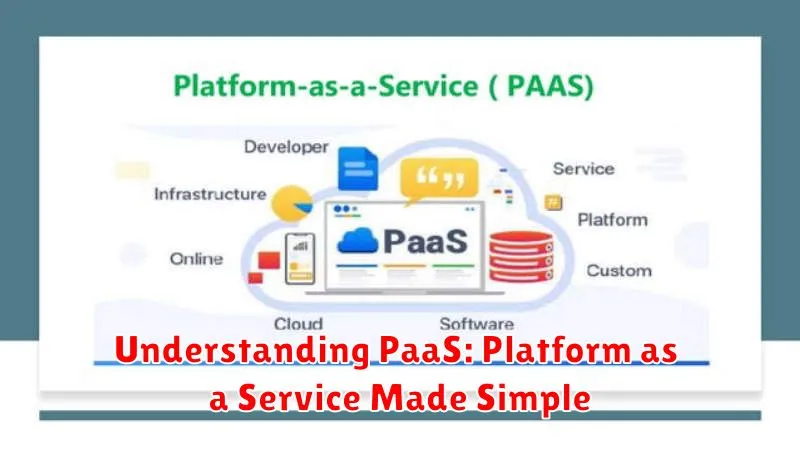In today’s rapidly evolving digital landscape, businesses are constantly seeking innovative solutions to streamline operations, enhance agility, and reduce costs. Platform as a Service (PaaS) has emerged as a powerful cloud computing model that addresses these needs by providing a comprehensive platform for developing, running, and managing applications without the complexities of managing underlying infrastructure. This article delves into the core concepts of PaaS, explaining its key benefits and illustrating how it simplifies the software development lifecycle.
Understanding PaaS is crucial for any organization looking to leverage the power of the cloud. From startups to large enterprises, PaaS offers a range of advantages, including reduced infrastructure management, faster time to market, improved scalability, and enhanced collaboration. This introduction will provide a foundational understanding of what Platform as a Service is, how it differs from other cloud service models like IaaS and SaaS, and why it has become an essential component of modern software development strategies.
What Is PaaS and How Does It Work?
Platform as a Service (PaaS) is a cloud computing model that provides developers with a complete environment for building, deploying, and managing applications. It delivers a framework that handles the underlying infrastructure, including servers, storage, networking, and operating systems. This allows developers to focus solely on building and deploying their applications without worrying about managing the complexities of the underlying hardware and software.
PaaS typically works through a web browser or an API. Developers use the provided tools and services to develop, test, and deploy their applications. Key components of a PaaS offering usually include an integrated development environment (IDE), middleware, databases, and other essential services.
The PaaS provider manages the infrastructure and ensures its availability, security, and scalability. This enables developers to deploy applications quickly and easily, without the need for extensive system administration expertise. Scalability is often handled automatically by the PaaS provider, allowing applications to adapt to changing demand.
PaaS vs IaaS vs SaaS
Understanding the distinctions between Platform as a Service (PaaS), Infrastructure as a Service (IaaS), and Software as a Service (SaaS) is crucial for choosing the right cloud service model. Each offers a different level of abstraction and control.
SaaS provides ready-to-use software applications over the internet. Users access these applications, like email or CRM software, without managing any underlying infrastructure. Think of it as renting a finished apartment – you just move in and use it.
PaaS offers a platform for developers to build, deploy, and manage applications. The underlying infrastructure, like servers and operating systems, is managed by the provider. This is like renting an apartment with the freedom to decorate and furnish it to your liking.
IaaS provides access to fundamental computing resources, such as virtual machines, storage, and networks. Users have significant control over the environment, including operating system choices and security configurations. Imagine buying a plot of land and building your own house – you have complete control, but also full responsibility.
Advantages for Developers and Startups

Platform as a Service (PaaS) offers numerous advantages for both developers and startups. For developers, PaaS significantly reduces the complexity of setting up and managing development environments. Simplified development is a key benefit, allowing developers to focus on building and deploying applications rather than infrastructure management. PaaS providers handle the underlying hardware and software, including servers, operating systems, databases, and middleware.
Startups, often operating with limited resources, benefit greatly from PaaS. Cost-effectiveness is a primary driver, as PaaS eliminates the need for upfront investments in hardware and software licenses. The scalability offered by PaaS is also crucial, allowing startups to easily adjust resources as their needs grow. This on-demand scaling allows businesses to adapt to fluctuating workloads and user traffic without significant upfront investment or management overhead.
Faster time to market is another critical advantage. PaaS enables rapid prototyping and deployment, allowing startups to quickly launch their products and gain a competitive edge. This rapid development cycle fostered by PaaS can be a decisive factor in a startup’s success.
Top PaaS Providers in 2025
The PaaS market is constantly evolving, with new players emerging and existing providers enhancing their offerings. Choosing the right platform depends heavily on specific business requirements. However, several providers consistently rank high in terms of market share and comprehensive features. As of 2025, these top contenders include established giants and innovative newcomers, each catering to a diverse range of development needs.
AWS Elastic Beanstalk continues to be a popular choice, providing a robust and scalable environment for deploying and managing applications. Its tight integration with other AWS services makes it a compelling option for businesses already invested in the AWS ecosystem.
Google App Engine offers a fully managed environment, simplifying deployment and scaling. Its focus on developer productivity and support for multiple programming languages makes it attractive for various application types. Microsoft Azure App Service provides a comprehensive platform with support for a wide array of frameworks and languages. Its integration with other Azure services makes it a powerful option for enterprise-level applications.
Heroku remains a favorite among developers for its ease of use and focus on developer experience. Its streamlined deployment process and extensive add-on marketplace make it a good choice for rapidly deploying and scaling applications.
Red Hat OpenShift is a strong contender in the enterprise PaaS space, offering a robust and flexible platform built on Kubernetes. Its open-source nature and focus on containerization make it attractive for organizations seeking greater control and portability.
Common Use Cases
Platform as a Service (PaaS) offers a versatile environment suitable for a variety of development and deployment scenarios. Rapid application development is a key strength, allowing teams to quickly build and deploy applications without managing complex infrastructure. This agility makes PaaS ideal for projects with tight deadlines or evolving requirements.
PaaS excels in supporting modern application architectures such as microservices and cloud-native development. The platform’s inherent scalability and flexibility simplify the deployment and management of these distributed systems. Furthermore, PaaS facilitates collaboration by providing a centralized platform where development teams can work together seamlessly.
Another compelling use case is testing and development environments. PaaS allows developers to quickly spin up isolated environments for testing new features or versions of applications without impacting production systems. This streamlines the testing process and reduces the risk of deployment errors.
Finally, PaaS is often employed for business analytics and intelligence. The platform’s integrated data services and analytics tools provide a powerful environment for processing and analyzing large datasets, leading to valuable business insights.
Security and Control Limitations
While PaaS offers numerous advantages, it’s crucial to acknowledge the inherent security and control limitations. Sharing resources and infrastructure with other users on the same platform introduces potential vulnerabilities. A security breach affecting one user could potentially impact others, though reputable providers invest heavily in mitigating such risks.
Vendor lock-in is another important consideration. Migrating applications and data from one PaaS provider to another can be complex and time-consuming due to proprietary technologies and APIs. Organizations should carefully evaluate the long-term implications of vendor lock-in before committing to a specific platform.
Furthermore, PaaS solutions may offer limited customization options compared to IaaS. While providing pre-configured environments simplifies development and deployment, it can restrict flexibility for applications with unique requirements. Organizations needing granular control over their underlying infrastructure might find PaaS less suitable.
Finally, data governance and compliance can be challenging in a PaaS environment. Understanding where data resides, how it’s processed, and who has access is crucial, particularly for organizations subject to strict regulatory requirements. Due diligence is required to ensure the chosen PaaS provider meets necessary compliance standards.
When to Choose PaaS Over Other Options

PaaS becomes a compelling choice when specific development and deployment needs align with its strengths. Speed and time-to-market are paramount considerations. If rapid prototyping, application development, and deployment are priorities, PaaS offers a streamlined environment to achieve these goals quickly. This is especially advantageous for startups and businesses operating in dynamic markets.
When scalability is a critical factor, PaaS provides robust solutions. The inherent elasticity of PaaS allows applications to scale resources up or down seamlessly based on demand. This ensures optimal performance and cost-efficiency by only utilizing the necessary resources at any given time.
PaaS is an excellent option when dealing with limited in-house expertise. By abstracting away the complexities of managing infrastructure, PaaS empowers teams to focus on development rather than server administration, database management, and other operational tasks. This reduces the need for specialized IT personnel and frees up resources for core business functions.
Cost considerations also play a significant role. PaaS often provides a cost-effective solution, particularly for small to medium-sized businesses. The pay-as-you-go model eliminates the upfront investment and ongoing maintenance costs associated with on-premises infrastructure. This translates to predictable operational expenses and greater financial flexibility.

